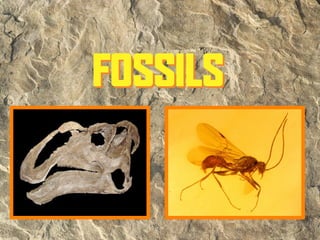
Fossils
- 2. What is a fossil? • A fossil is the preserved remains of a once- living organism (at least 10,000 yrs. old). • Latin: fossilis (something dug up) What do fossils tell us? • Fossils give clues about organisms that lived long ago. They help to show that evolution has occurred. • They also provide evidence about how Earth’s surface has changed over time. • Fossils help scientists understand what past environments may have been like.
- 3. The Fossil Record All of the fossils that exist are part of the Fossil Record •Includes fossils that have yet to be discovered •Paleontologists- study life in the past 3
- 4. Questions 1. What types of organisms existed in the past? 2. What did the oceans look like over different time periods? 3. What did the land look like over different time periods? 4. How did organisms move about? 5. How did behaviors, such as flight, evolve? 4
- 5. HOW IS A FOSSIL FORMED? 1. Sediment 2. Layers 3. Movement 4. Erosion An animal is buried by More sediment layers Movement of tectonic Erosion from rain, sediment, such as accumulate above the plates, or giant rock rivers, and wind wears volcanic ash or silt, animal’s remains, and slabs that make up away the remaining shortly after it dies. Its minerals, such as Earth’s surface, lifts rock layers. Eventually, bones are protected silica (a compound of up the sediments and erosion or people from rotting by the silicon and oxygen), pushes the fossil digging for fossils will layer of sediment. slowly replace the closer to the surface. expose the preserved calcium phosphate in remains. the bones.
- 6. FIVE MAIN TYPES OF FOSSILS Petrified Molds and Carbon Fossils Casts Films Trace Preserved Fossils Remains
- 7. PETRIFIED FOSSILS • The word “petrified” means “turning into stone.” • Petrified fossils form when minerals replace all or part of an organism. • Water is full of dissolved minerals. It seeps through the layers of sediment to reach the dead organism. PETRIFIED FOSSIL The Field Museum in Chicago When the water evaporates, displays a fossil of a only the hardened minerals Tyrannosaurus rex. are left behind.
- 8. MOLDS AND CASTS • A mold forms when hard parts of an organism are buried in sediment, such as sand, silt, or clay. MOLD FOSSIL • The hard parts completely dissolve This mold, or imprint, is of over time, leaving behind a hollow an extinct mollusk called area with the organism’s shape. an ammonite. • A cast forms as the result of a mold. • Water with dissolved minerals and sediment fills the mold’s empty spaces. CAST FOSSIL • Minerals and sediment that are left This ammonite cast was in the mold make a cast. discovered in the United Kingdom. • A cast is the opposite of its mold.
- 9. CARBON FILMS • All living things contain an element called carbon. • When an organism dies and is buried in sediment, the materials that make up the organism break down. • Eventually, only carbon FERN FOSSIL remains. This carbon-film fossil of a • The thin layer of carbon fern is more than left behind can show an 300 million years old. organism’s delicate parts, like leaves on a plant.
- 10. TRACE FOSSILS • Trace fossils show the activities of organisms. • An animal makes a footprint when it steps in sand or mud. • Over time the footprint is buried in layers of sediment. Then, the sediment becomes FANCY FOOTWORK This dinosaur footprint was solid rock. found in Namibia, Africa.
- 11. PRESERVED REMAINS Some organisms get preserved in or close to their original states. Here are some ways that can happen. Amber Tar Ice An organism, An organism, An organism, such as an insect, such as a such as a woolly is trapped in a mammoth, is mammoth, dies in tree’s sticky resin trapped in a tar pit a very cold region. and dies. More and dies. The tar Its body is frozen resin covers it, soaks into its in ice, which sealing the insect bones and stops preserves the inside. It hardens the bones from organism—even into amber. decaying. its hair!
- 12. Earth Systems Science Most fossils form when organisms are buried in sediment Natural Cycle: The Rock Cycle •Abiotic factors such as wind, rain, ice, and sun weather rocks •Form sediments that are eroded by water, landslides, or wind •Deposited and accumulate over time to cover the remains of organisms/traces 12
- 13. Burial • Quick burial is important! • Abiotic (non-living)and biotic (living) factors destroy most bodies before they become fossils. • Macroscopic and microscopic scavengers, predators, decomposers, 13
- 14. Which Organisms Become Part of the Fossil Record? • Soft Body Parts: skin, muscle • Hard Body Parts: bone, teeth, shells, and wood. • Oldest body fossils? • Phanerozoic Eon, Cambrian Period (Trilobites) 14
- 15. Review Pre-Cambrian Life • Hadean Eon: no fossils • Archean Eon: only trace fossils of prokaryotic organisms (no true nucleus, other organelles) Stromatolites • Proterozoic Eon: first eukaryotic organisms, Stromatolites reach greatest abundance, still no body fossils 15
- 16. Inorganic vs. Organic • Inorganic exoskeletons very resistant to destruction • Calcium • Some inorganic exoskeletons connected with organic material. Unlikely to find these species in one “piece” ie. sea urchin 16
- 17. Location, Location, Location… • Underwater • Close to run-off carrying sediment • Still water Nice neighborhoods: • Lakes, ocean, rivers, swamps, deltas, lagoons Bad neighborhoods: • Intertidal zone, Rainforests 17
- 18. The Fossil Record The Fossil Record is NOT complete •Organisms live and die in different environments •Only some remains resist destruction •Of those only some will fossilize Fewer than 10% of the organisms alive today will become fossils. 18